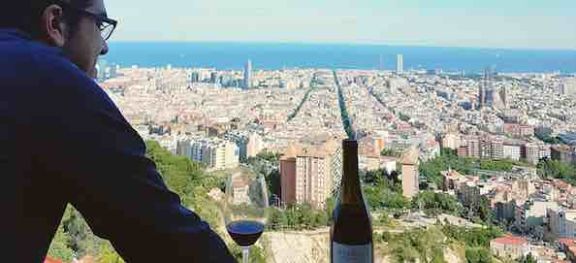Joan d’Anguera, Altaroses Garnatxa 2015 Montsant

From €11.65, $15.99, CA$22.65, £16
Today is an emotional day for me because for the first time since I started writing for JancisRobinson.com four years ago I am presenting a wine of the week.
In this slot one can talk about truly motivating wines, wines chosen on a very personal level leaving behind the pressure of scoring and, in my case, relaxing about my obsession: objectivity.
That is why I decided to head with a bottle of Altaroses 2015, a corkscrew and a Riedel Bordeaux glass, to one of my favourite corners of Barcelona, a secret and peaceful balcony high above the city, accessible only by foot and far away from any noise.
As you may have noticed, I always prefer to taste blind. I am an emotional taster and for me it is difficult to separate the emotional and rational aspects when I see the label. But today, I am in something of a reverie, Barcelona below me as you can see, drinking a very singular wine. Altaroses is produced by Joan d’Anguera, a winery run by two brothers, Josep and Joan d’Anguera, who have navigated uncharted terrain since 2012 when they decided to radically change the style of their wines from powerful, thick and dark to showcase the most delicate, light and sympathetic expression of the Grenache grape, known as Garnatxa in our local Catalan language.

The family roots in wine go back to 1820, but it was not until 1984 that their father decided to bottle the first wine under the name of Joan d’Anguera. The brothers took over the winery in 2000 when muscular, very ripe wines obsessed the market, and that was the style followed by them. They are located in Darmos, the lowest area to the south of the Montsant appellation where most producers follow Priorat in terms of style.
The reasons for their radical change were the simplest but most powerful in life: humanity. In 2008 the brothers met Joan Valencia of Cuvée 3000, an important Barcelona wine distributor. Natural wines fascinate Joan Valencia and the word drinkability is always on his lips. The three of them started to taste together and the brothers were soon inspired to look for drinkability in their wines. It was just a matter of time to decide how and when to make the move towards elegance and charm.
Altaroses 2015 is a 100% biodynamically certified Grenache, not destemmed, and crushed by foot. The maceration is very soft and takes just 15 days with three punchdowns by foot during the process. The wine is aged in five- to six-year-old barrels for one year, and oak flavours are almost imperceptible. They use very little sulphites both during ageing and when bottling. In 2015 they made 35,000 bottles of this wine but they are transforming their vines from trellised to bush vines, which will shrink average annual production to about 25,000 bottles.
I am amazed by the pale ruby colour that has an almost crystalline aspect. The nose is pure, very clean, intense and without a single signal of over-extraction. The pure, ripe red fruit aroma has a touch of liquorice and archetypal mild cherry liquor notes. I enjoy its delicate aspect, deliciously simple appeal, and low levels of ripe-but-caressing, superbly integrated tannins. It has a bright fruit character supported with a lifted, mouth-watering mineral acidity. The wine is quintessentially what the French call aérien, and may be described as ethereal in English, with a delicate sweetish aftertaste. It may not be the most complex wine I have tasted, but I am thrilled by its less-is-more profile. This is a benchmark wine and I would love to see more producers taking this direction.

The move towards lighter, more delicate Grenache/Garnacha has reached other parts of Spain: Garnacha from Mustiguillo in Valencia, Cifras Garnacha from Bodegas Exeo in Rioja, El Terroir from Domaines Loupier in Navarra and Rozas 1er Cru from Comando G in Gredos are other superlative examples.
We still need time to understand the ageing ability of Altaroses. I have my doubts about Garnatxa being a long ageing grape variety and I would recommend a drinking window that ends in 2022 at the very latest. Honestly speaking, it is so beautiful and bright now that I would prefer to drink it within one year.
I would recommend lightly chilling the wine before opening it; 14-16 ºC is a great temperature to enhance freshness. It is a versatile wine, the light tannin and its delicate aspect can pair with lots of different culinary preparations, but a simple and delicious pairing would be with a full array of Catalan cured meat and cold cuts.
You can’t imagine how grateful I am. I keep thinking about how good it feels to leave behind the rigour of rating for one day, but I promise I will be back soon, trying to be as neutral as usual, always having the words of Abraham Maslow, one of the main exponents of humanistic psychology, in my head: dispassionate objectivity is itself a passion for truth.
The wine is widely available in Spain, of course, and is very well distributed in the US. It is imported into the UK by new-wave Spanish promoter Indigo Wines and wine-searcher.com currently lists two British retailers, one in Scotland and one in London. The wine is also available from the Canadian SAQ monopoly in Quebec.
Become a member to view this article and thousands more!
- 15,416 featured articles
- 274,319 wine reviews
- Maps from The World Atlas of Wine, 8th edition (RRP £50)
- The Oxford Companion to Wine, 5th edition (RRP £50)
- Members’ forum
- 15,416 featured articles
- 274,319 wine reviews
- Maps from The World Atlas of Wine, 8th edition (RRP £50)
- The Oxford Companion to Wine, 5th edition (RRP £50)
- Members’ forum
- Commercial use of our Tasting Notes
